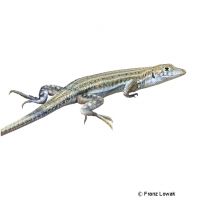Bosk's Fringe-fingered Lizard (Acanthodactylus boskianus)
| Bosk's Fringe-fingered Lizard Acanthodactylus boskianus | |
|---|---|
| Name | Bosk's Fringe-fingered Lizard |
| Name Lat. | Acanthodactylus boskianus |
| Family | Lacertids |
| Family lat. | Lacertidae |
| Order | Scaled Reptiles |
| Order lat. | Squamata |
| Origin | Africa |
| Habitat | Desert, Semi-desert |
| Diet | Live insects |
| Humidity | 40-60 % |
| Behavior | ♂ territorial |
| Keeping | Individual, pair, harem |
| Care Level | Easy |
| Reproduction | Oviparous |
| Housing | Dry terrarium |
| Life Span | 2-4 years |
| Protection | No |
| Metric Units | |
| Size | 20 cm |
| Temperature | 25-30 °C |
| Temperature Local | 40-45 °C |
| Housing Size | 80 x 60 x 40 cm |
| US Units | |
| Size | 8" |
| Temperature | 77-86 °F |
| Temperature Local | 104-113 °F |
| Housing Size | 30" x 25" x 15" |
Distribution and habitat
The distribution range of the diurnal African Fringe Finger extends over the entire North African region, from Mauritania, Mali and Niger through Egypt and the Arabian Peninsula to Syria. They live mainly in deserts and semi-deserts with solid underground.
Maintenance
Minimum dimensions for the terrarium, according to the size and number of animals
| 1-2 animals | 6KRL x 4KRL x 3KRL (L x W x H) |
Head-torso length (KRL) is measured on the largest animal. For each additional animal, increase the footprint by 15%. A terrarium of e.g. L 80 x W 60 x H 40 cm is recommended, which should be placed in a quiet and vibration-free place
You need a terrarium with flat branches, stone structures (hiding places, visual protection, resting places) and structured back and side walls (e.g. cork covering), a shallow water bowl as well as a graveable substrate of sand or sand-clay mixture and planting for decoration (succulents, ornamental grasses, cacti etc.). A small portion of the substrate, especially the lower sand layers, should always be kept slightly moist. Once a week, preferably in the evening, the inside of the terrarium should be finely sprayed with water (humidity), but not directly the animals
| Temp. day: 25-30 °C | Temp. night: 20-22 °C | Temp. local: up to 45 °C | Humidity: 40-60 |
Thermostatically controlled floor heating is recommended. The lighting duration must be 10-14 hrs. depending on the season. Special lamps that produce the necessary heat and UV light are ideal. Daily UV irradiation is essential.
Diet
The food supply consists of live insects, such as crickets, house crickets, smaller grasshoppers or cockroaches. In addition, commercially available ready-made food for insectivorous reptiles can also be offered, possibly with tweezers for habituation. Wax moths should rarely be fed in small amounts to adults, but not to juveniles, because of their large fat content. Young animals should be offered food daily, adults 4-5 times a week. Regular addition of minerals and vitamins (dusting of feed) is important. Drinking water must always be available
A varied diet promotes health and prevents deficiency symptoms.
Reproduction and breeding
Adult males are usually larger and more powerfully built than females and can be recognized by their preanal pores (pore-like openings in front of the anal fissure). The female buries usually 2-7 eggs in the sandy, moist substrate several times per year. At a temperature of 24-26 °C the incubation period is about 90-100 days. As first food for the young animals small insects like fruit flies and micro crickets are suitable.
Important
Adult males are very territorial and incompatible with each other. However, they can be kept well in a group, one male with 2-4 females. Elevated sunny spots are readily visited by the sun-loving animals.
For hibernation, the lighting duration is shortened by 2-3 hours for about 2 months and the temperature is lowered by 3-5 °C.
The quality of the food animals can be upgraded by giving fruit and honey water as food.
The terrarium must have good ventilation without drafts and meet the species specific needs. Measuring devices such as thermometers, hygrometers, etc. are necessary. The lighting has to correspond to the species-specific day-night rhythm and has to be placed in such a way that the animals cannot injure themselves. The terrarium should be locked in such a way that neither unauthorized persons can open it nor the animals can escape. Contamination must be removed regularly
Further literature can be found in your pet store.
References
Text: Christian Sänger; Image: Franz Lowak
Source: ENGELMANN (2006): Zootierhaltung - Tiere in menschlicher Obhut: Reptilien und Amphibien, Harri Deutsch Verlag; BMELV (1997): Mindestanforderungen an die Haltung von Reptilien
- Gemäß § 21 Abs. 5 Tierschutzgesetz idgF
